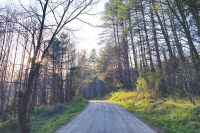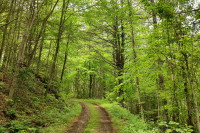The players
Property owners: A survey was mailed to all 811 Lake Junaluska property owners last week, with a robust response rate so far. There are 765 homes at Lake Junaluska. About half are lived in year-round by their owners. Surveys also went to owners of lots and a handful of commercial entities on the grounds.
SEE ALSO: Ongoing coverage
Lake Junaluska Future Task Force: A 13-member, appointed task force that has studied the ins and outs of the options with the intensity and thoroughness of NASA space shuttle inspectors. Consists primarily of Lake Junaluska residents, with two Lake Junaluska officials and one Waynesville official.
Lake Junaluska Community Council: A seven-person body elected by Lake Junaluska homeowners to address neighborhood issues and represent residential interests. The council parleys with the Conference and Retreat Center, which manages public works and carries out residential services paid for through homeowners fees.
Lake Junaluska Assembly Board of Directors: A 32-member body that oversees big picture operations for the Lake Junaluska Conference and Retreat Center. Its members consist mostly of Methodist Church leaders and appointments, with just a handful of local residents or community leaders. It is considered the “official” decision-making body for the Lake Junaluska community and holds the definitive “vote.”
Waynesville Board of Aldermen: The five-member elected town board must decide if it wants Lake Junaluska. One public hearing was held already to gauge the views of the town’s current populace, but town residents did not show up.
N.C. General Assembly: If Lake Junaluska leaders decide to become part of Waynesville, and if Waynesville agrees, state lawmakers would have to consecrate the deal. Language for a bill is already in the drafting stages, so it would be ready to roll if it’s ultimately needed. A bill’s chances of passing in Raleigh hinge on how strong and loud the call is from all the other players here.
Junaluska’s choices: the abridged version
Option 1: Join the town of Waynesville
Pros:
• Financial savings — This is the cheapest option, thanks to economies of scale. Residents would fork over town property taxes, but it would buy them all the services and amenities they currently pay for through their homeowners’ fees, which would go away. Plus, the town would pick up the tab for $10 million in critical infrastructure repairs — the elephant in the room being antiquated water and sewer lines — that are needed in the coming decade.
SEE ALSO: Ongoing coverage
• Big brother to lean on — The headaches of street sweeping, snow plowing, trash pick-up, police protection, fixing potholes — and did we mention fixing those crumbling water and sewer lines? — will be someone else’s problem now.
• Match made in Heaven — As far as towns go, Waynesville’s a nice one. Given the typical demographics of Lake Junaluska residents — well-educated, upper-middle class and philosophically progressive — Waynesville is seen as a town that reflects their own ideals. A merger wouldn’t exactly be plowing new ground. Waynesville and Lake Junaluska have had a symbiotic relationship for the past century.
Cons:
• Loss of identity — Junaluskans are steeped in pride for the place they call home. Their community spirit has a long lineage, dating back to the founding of the Methodist conference and retreat center a century ago. The Methodist ties and shared affinity for the Christian retreat at the community’s core still run deep. With a big brother to look after them, will Lake Junaluska residents slowly lose their sense of ownership and commitment? Will Junaluskans identity and allegiances, even if subconsciously, be muddied if they become Waynesvillians?
• Can you hear me now? — Lake Junaluska is home to 638 registered voters. Waynesville has 6,652 registered voters. Lake Junaluska’s voice in the political process could make it a small fish in a big pond.
• Get in line — Waynesville leaders have made clear that if the lake becomes part of the town, it will be treated the same as everyone else. Their needs won’t be put at the bottom — but nor will they be put at the top. To quote Town Manager Marcy Oneal: “They would simply all become town of Waynesville projects and be slotted in line accordingly.”
• No going back — If Lake Junaluska marries itself to Waynesville, there would be no annulments.
Option 2: Become its own brand-new town
Pros:
• Self rule — Does 1776 ring a bell? Lake Junaluska residents would be their own elected leaders, ensuring every decision affecting the community is what it wants for itself. What to charge for property taxes, what zoning and planning rules to enact, or what streets get paved each year would be made at the local level.
• Sense of pride — Junaluskans could easily maintain their shared identity, common spirit and community engagement.
• Perks — Being a town would make it eligible for a cut of state sales tax revenue, state grants, state funding for street and sidewalk maintenance and others benefits being a real town afford.
Cons:
• Big to-do list — A new town would need to elect a board, hire staff, find a building to serve as “town hall,” buy computers and phones, create a budget and start collecting taxes fast to provide the same high level of services Lake residents are accustom to.
• Shouldering risk alone — The onus of meeting the town’s needs falls on comparatively fewer backs. A small hiccup for a large town could be a deafening blow for a tiny one, such as the huge capital cost associated with water and sewer line repairs.
• Get your checkbook ready — This option is most expensive. There are no economies of scale when trying to deliver a full suite of town amenities to such a small number of residents. (There are roughly 800 homes.)
• Legislative deal killer — The General Assembly has arduous rules and requirements for new towns trying to incorporate.
Option 3: Stay the same
Pros:
• If it ain’t broke — Lake Junaluska already walks like a town and talks like a town. In fact, residents enjoy more services than some bona fide towns do. Why add a layer of municipal bureaucracy?
• Been there, done that — Junaluskans are comfortable with their current structure as a sophisticated homeowners association. Fees paid by property owners fund public works and services. An elected community council serves as a sounding board for issues and concerns. The system has worked for decades.
• Come to momma — Founded a century ago as a Methodist summer retreat, Lake Junaluska is no longer a church enclave. But the burgeoning residential neighborhoods that circle Lake Junaluska today are still inextricably linked to the Methodist conference and retreat center at its core — physically, historically and spiritually. Lake Junaluska Conference and Retreat Center manages residential operations, reinforcing the generational ties many homeowners have for the Methodist retreat.
Cons:
• Money pit — Junaluska residents would see a steep hike in the existing fees they pay in order to fund the expensive infrastructure repairs the lake needs during the next decade — first and foremost replacing outdated water and sewer lines. The community has no fall back other than its own wallets.
• No representation — Lake Junaluska residents rely on the good will and graces of the Lake Junaluska Conference and Retreat Center to do right by the surrounding neighborhoods. An elected community council passes along the issues, concerns and priorities of the residential community to the Lake Junaluska public works administration to carry out, but at the end of the day, is only an advisory board. While the conference and retreat center has rarely, if ever, clashed with the residents’ wishes, there are no guarantees.
One foot in the past, one in the future, Junaluskans weigh the worth of their identity
 When Ken Zulla hung up his IRS badge and retired to the well-groomed mountain hamlet of Lake Junaluska more than a decade ago, monthly sojourns to the local feed-and-seed store weren’t on the radar for his Golden Years.
When Ken Zulla hung up his IRS badge and retired to the well-groomed mountain hamlet of Lake Junaluska more than a decade ago, monthly sojourns to the local feed-and-seed store weren’t on the radar for his Golden Years.
SEE ALSO: Ongoing coverage
Merger input sought in countdown to decision
Waynesville residents will get their first chance to weigh in on the possibility of adding Lake Junaluska to the town limits with two public hearings this month.
Lake Junaluska winnows options as merger window narrows
Lake Junaluskans got their first glimpse this weekend at what it would take for the community to become its own town.
Incorporating as its own town comes with a host of regulatory, political and logistical hurdles. A task force studying the future course of Lake Junaluska residential neighborhoods heard a report on the ins-and-out of forming their own town at a public meeting Jan. 26.
Timeline for Waynesville, Lake Junaluska merger picks up speed
 Lake Junaluska and the town of Waynesville are pressing ahead with the possibility of a merger. The two entities have put the wheels in motion to introduce a special bill in the N.C. General Assembly in March that would bring Lake Junaluska into Waynesville’s town limits.
Lake Junaluska and the town of Waynesville are pressing ahead with the possibility of a merger. The two entities have put the wheels in motion to introduce a special bill in the N.C. General Assembly in March that would bring Lake Junaluska into Waynesville’s town limits.
Build it and they will come
 Back in spring of 2011 I wrote about a wetlands restoration project at Lake Junaluska - www.smokymountain news.com/archives/item/3686-a-perfect-fit. Candace Stimson, in order to fulfill her Low Impact Development degree at Haywood Community College, unearthed Suzy’s Branch behind Jones Cafeteria and created about 100 feet of free-flowing stream and wetlands.
Back in spring of 2011 I wrote about a wetlands restoration project at Lake Junaluska - www.smokymountain news.com/archives/item/3686-a-perfect-fit. Candace Stimson, in order to fulfill her Low Impact Development degree at Haywood Community College, unearthed Suzy’s Branch behind Jones Cafeteria and created about 100 feet of free-flowing stream and wetlands.
Waynesville and Lake Junaluska talk merger
 As Lake Junaluska residents chart a future course for their community, two options now remain on the table: become its own town or merge with the town of Waynesville.
As Lake Junaluska residents chart a future course for their community, two options now remain on the table: become its own town or merge with the town of Waynesville.
For decades, Lake Junaluska has operated as a well-oiled homeowners association — with its own security force, trash pick-up, water and sewer service and other amenities normally only found in actual towns.
Exploding waterfowl population prompts feeding ban at Lake Junaluska
 As the first chunk of bread was tossed in the air, a swarm of ducks and geese at Lake Junaluska swiftly waddled toward the source of the handout, a chorus of quacks and honks rising up from the flurry of feathers.
As the first chunk of bread was tossed in the air, a swarm of ducks and geese at Lake Junaluska swiftly waddled toward the source of the handout, a chorus of quacks and honks rising up from the flurry of feathers.
An authentic taste: Stuart Auditorium welcomes 42nd Smoky Mountain Folk Festival
 Mountain music, dancing and tradition will be on display once again on the shores of beautiful Lake Junaluska as the Smoky Mountain Folk Festival, now in its 42nd year, celebrates the culture and heritage of Western North Carolina.
Mountain music, dancing and tradition will be on display once again on the shores of beautiful Lake Junaluska as the Smoky Mountain Folk Festival, now in its 42nd year, celebrates the culture and heritage of Western North Carolina.













